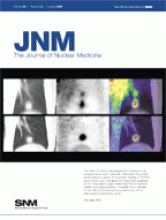“Amphibian cars” for molecular imaging: Boerman and Oyen looks at the challenges surrounding development of hybrid PET/MRI scanners and previews an article in this issue of JNM introducing a molecular probe that provides a signal in both modalities.
Page 1213
Single-session PET/CT staging mammography: Heusner and colleagues compare the diagnostic accuracy of an all-in-one protocol of whole-body 18F-FDG PET/CT and integrated 18F-FDG PET/CT mammography with that of a multimodality algorithm for initial breast cancer staging.
Page 1215

Breath-hold PET/CT in lung cancer: Kawano and colleagues describe the advantages of breath-hold over free-breathing PET/CT in providing more precise measurement of maximum SUVs.
Page 1223
Optimal imaging for paraganglioma: Koopmans and colleagues evaluate the diagnostic accuracies of 111In-octreotide somatostatin receptor scintigraphy, 123I-MIBG scintigraphy, and morphologic imaging in patients with highly suspected head and neck paragangliomas.
Page 1232
Gene modulation of 18F-FDG kinetics: Strauss and colleagues use PET imaging and histopathologic results to assess the effects of angiogenesis-related gene expression on 18F-FDG kinetics in patients with primary colorectal tumors.
Page 1238
11C-choline PET in hepatocellular cancer: Yamamoto and colleagues explore the potential utility of 11C-choline PET as a complement to 18F-FDG PET in the detection of hepatocellular carcinoma lesions.
Page 1245

11C-(R)-PK11195 imaging in AD: Tomasi and colleagues report on a reference region model for estimating the binding potential of a PET radiotracer that shows increased microglial activity and decreased vascular binding in individuals with Alzheimer's disease.
Page 1249
Opioidergic system and rewards: Schreckenberger and colleagues use 18F-DPN to investigate the neurobiologic correlates of reward dependence and discuss the implications of these findings for predicting predisposition to addictive behavior.
Page 1257

Voxel-based diagnosis of Alzheimer's disease: Mikhno and colleagues explore the utility of 11C-PIB PET imaging of amyloid-β accumulation in discriminating healthy individuals from those with Alzheimer's disease.
Page 1262

Novel transporter radioligand: Arakawa and colleagues report on several methods for quantification of (S,S)-18F-FMeNER-D2, a PET imaging agent with promise for direct estimation of norepinephrine transporter occupancy by antidepressants.
Page 1270

Reversal of vascular 18F-FDG uptake: Lee and colleagues evaluate serial changes in vascular 18F-FDG uptake in response to lifestyle interventions and discuss the potential use of this technique in atherogenic risk reduction.
Page 1277

Gated SPECT in atrial fibrillation: Sciagrà and colleagues examine differences in myocardial perfusion between simultaneously acquired gated and nongated SPECT data in patients with atrial fibrillation and provide recommendations for optimal assessment.
Page 1283
Viability in ventricular aneurysms: Zhang and colleagues describe long-term benefits of SPECT and PET in assessing the viability of aneurysmal myocardium in patients with ischemic cardiomyopathy and compare short-term results in those undergoing revascularization or revascularization plus aneurysmectomy.
Page 1288

Human biodistribution of 99mTc-N-DBODC: Cittanti and colleagues assess the safety profile and biodistribution of a new myocardial perfusion tracer that promises to provide early and high-quality SPECT images of the left ventricle.
Page 1299

Overview of SPECT/CT: Buck and colleagues offer an educational review of the current status and future prospects of hybrid SPECT/CT in cardiac, neurologic, and oncologic applications.
Page 1305
Diabetes and myocardial glucose use: Shoghi and colleagues investigate myocardial glucose metabolism in a rodent model of type 2 diabetes and validate PET measurements of glucose uptake against gene and protein expression of glucose transporters.
Page 1320
Functional P-gp activity at the BBB: Bankstahl and colleagues use (R)-11C-verapamil PET and tariquidar, a new-generation P-glucoprotein modulator, to study functional activity at the blood–brain barrier in rats.
Page 1328

Pharmacokinetics of 99mTc(N)-DBODC(5): Bolzati and colleagues elucidate the mechanisms of distribution, retention, and elimination of a promising myocardial imaging agent and describe the potential for extension to tumor imaging and noninvasive multidrug resistance studies.
Page 1336
Imaging PtdE availability: Zhao and colleagues report on the development of 99mTc-duramycin as a novel molecular probe for imaging phosphatidylethanolamine, a major phospholipid externalized to the surface of apoptotic cells and accessible in necrotic cells.
Page 1345
Cytotoxicity of 111In-DTPA-hEGF: Cai and colleagues investigate the relationships among human epidermal growth factor expression, DNA damage, and cytotoxicity in cells exposed to an Auger electron–emitting radiopharmaceutical.
Page 1353

PET/MRI in pancreatic cancer: von Forstner and colleagues compare uptake of 18F-FDG, 18F-FLT, and 18F-FEC in human pancreatic tumor cell lines in mice and correlate tumor uptake with gene expression of membrane transporters and rate-limiting enzymes.
Page 1362

Bifunctional PET/MRI probe: Lee and colleagues detail the development of a bifunctional iron oxide nanoparticle probe for PET and MRI scans of tumor integrin αvβ3 expression.
Page 1371


99mTc-HMPAO in RA: Bennink and colleagues assess the biodistribution and radiation dosimetry of 99mTc-HMPAO–labeled monocytes in adult patients with rheumatoid arthritis and describe the potential applications in noninvasive monitoring of therapy and disease progression.
Page 1380
18F-FDG in colorectal tumor cells: Sharma and Smith look at therapy-induced changes in tracer incorporation at the tumor cell level in response to conventional and novel chemotherapy agents.
Page 1386
Case against radioiodine ablation: Hay and colleagues take issue with widely used postoperative radioiodine remnant ablation as adjuvant therapy in patients with well-differentiated thyroid carcinoma and outline reasons for suggesting that ablation is often the wrong choice.
Page 1395
ON THE COVER
The maximum SUV of free-breathing PET should not be accepted as accurate, especially in the lower lung and for small pulmonary lesions. In this patient, blurring of 18F-FDG accumulation was more apparent in fusion free-breathing PET/CT (top) than in fusion breath-hold PET/CT (bottom). Breath-hold imaging realizes a complete match between CT and PET and is thus recommended as part of the standard protocol for lung cancer.

See page 1229.







